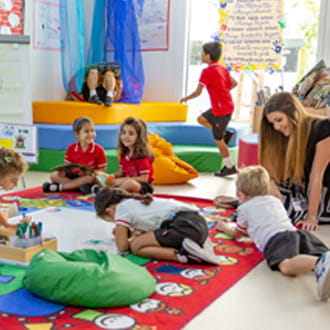We use cookies to improve your online experiences. To learn more and choose your cookies options, please refer to our cookie policy.

In our popular blog entry, “Questions to ask your children after the school day,” one of the most effective and engaging questions we listed was “Would you like to learn more about math, reading, writing or science in school?” Now imagine if that question were asked in school, every day, and actually acted upon? What if young children, in the most exploration-focused years of their life, could have agency in what they learned in school, and were directed towards where their aptitudes pointed? This is the essence of child-led learning.
The foundation of child-led learning is the idea that the school should not be the sole decision-maker when it comes to the direction of learning, and that it should collaborate with the students themselves to plan the curriculum. Derek Wenmoth, Principal Consultant at New Zealand-based education consultancy firm CORE Education, says: “When learners move from being passive recipients to being much more active in the learning process, and actively involved in the decisions about the learning, then they have greater agency.” Examples of the provision of this agency include small things such as including students in parent teacher meetings, or a dedicated whiteboard where students can write questions and work together with faculty and classmates to solve them. The result of this agency? Students feel more invested in what they’re learning, and because they helped choose the path of education that was taken, they are more engaged as well. Having ownership and responsibility even in this age can be a powerful motivator for improved learning experiences. Children are vastly more intelligent and insightful than many adults give them credit for. Even at this young developmental stage, they’re capable of directing inquiry and posing deep questions. Taking advantage of this ability is key to child-led learning.
While the concept of child-led learning must be essentially integrated into the curriculum before it can truly be considered a holistic application, there are certain changes that can be made to encourage it.
Makerspaces harness the power of hands-on creation to drive learning. By offering a space filled with crafting tools, both high-tech and low-tech, and giving users the opportunity to use them freely to create what they want, makerspaces provide children an avenue of learning that is entirely directed by them. They can come into a makerspace and do whatever they want, explore any curiosities that they have.
Investigative projects on topics chosen by students are among the best ways to get child-led learning. By assigning them topics, but giving them the freedom to choose how they approach the topic, students are made to think critically and exercise their problem-solving skills. By the end of the project, students will have complete ownership over their work, as they alone decided the means by which they explore their assigned topic.
Every student has their own aptitudes, strengths, weaknesses, and preferences. A school must take these into account and tailor their education to each student’s unique needs. This is the foundation of student-centered learning environments, which are highlighted by strong engagement, focus of wisdom over knowledge, and a greater sense of guidance rather than passive lectures.
At Swiss International School in Dubai, our desire to create a student-centered learning environment and give every child the best education they can receive, has provided us with impetus to work on child-led learning. We establish student-led conferences that fully involve both students and parents in the process of learning, in which teachers merely facilitate. There are also three-way conferences that engage all three equally in the discussion of learning. Our Innovation Labs are open for all students to use before and after school hours, allowing them to explore technologies such as programming, 3D printing, and robotics at their leisure, providing for learning outside the classroom in whatever direction they want. We also have numerous events and projects throughout the year where students are a major part of the planning process, allowing them to influence the direction and presentation of many events that happen for their Grade or Year. All this is woven through the fabric of the International Baccalaurate curriculum, which truly upholds the agency of every child in determining what and how they learn. Every child’s education is tailored to them, allowing them to grow as they need to, and take ownership of the paths they take in life.